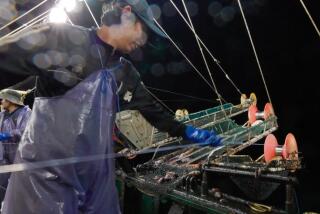Shrimp Farming Booms
- Share via
Commercial shrimp farming has increased dramatically in the last seven years, causing retail prices to drop and threatening the livelihood of fishermen, according to a San Diego-based trade publication.
Last year, for instance, farms were responsible for producing 22% of the world’s supply of this expensive and popular crustacean, Aquaculture Digest recently reported.
“The industry has quietly grown into a multibillion-dollar giant, lowering the prices in some markets and sending tremors through the shrimp-fishing industry,” the article stated.
Just as quietly, farmed shrimp have become the world’s largest and most valuable aquaculture species, easily surpassing similar efforts to cultivate salmon, catfish and trout.
More than 450,000 metric tons of farm-raised shrimp came to market last year with a $6 billion retail value. And total tonnage would have been 10% greater had not Bangladesh and Taiwan both experienced problems with their operations, the magazine found.
Most shrimp aquaculture ventures are based in Asia, with the People’s Republic of China believed to be the world leader with 22% of the total production. Other major producers include Ecuador, Taiwan, Indonesia, Thailand and the Philippines.
Aquaculture Digest estimates that more than 40 countries farm shrimp to some degree whether in inland ponds, tanks or along coastal bays. The United States plays only a minor role in the global industry, and the domestic effort, about 20 facilities, is based in South Carolina, Texas and Hawaii.
The cumulative effect of these ventures has caused the wholesale and retail prices of medium-sized shrimp to decline. Farmers have yet to successfully produce the larger varieties; prices for these shrimp species remain unchanged and, in some cases, have even increased.
There is a centuries-old tradition of fish farming in Southeast Asia. The modern industry, however, dates back only to the late 1970s.
Despite the successes of the last decade, the process is vulnerable. According to Aquaculture Digest, Bangladesh lost much of its 1988 crop because of floods. The reason for a 70% reduction in Taiwan’s harvest last year has yet to be ascertained.
Natural disasters aside, the industry’s greatest obstacle continues to be the difficulties in hatching shrimp larvae. The hatcheries remain the “weakest link” in the process, according to the report, because larvae are readily susceptible to bacterial and viral disease there.
Even so, the technology is much more reliable and cost-effective than the labor-intensive fishing methods in practice today. Furthermore, the wild-shrimp population has been depleted throughout the world because of overfishing and a general deterioration in water quality.
“A farmer can produce shrimp cheaper than a fisherman can catch them,” said Bob Rosenberry, publisher of Aquaculture Digest.
Because of this disparity the fisherman will eventually become obsolete, he said.
Aquaculture Digest estimates that several countries are undergoing a “boom” in shrimp farming that will far surpass current production levels, notably Thailand, the Philippines and China.
Of regional importance, Mexico has also made a major financial commitment to aquaculture despite the presence of a sizable shrimp fleet.
“Shrimp farming is on the verge of taking off in Mexico. Currently it has 70 farms, eight hatcheries, 25,000 acres in production and annual (harvest) of 9,000 metric tons,” the article stated.
“Shrimp farming is developing at a very rapid pace throughout the world,” said Rosenberry. “Some countries, such as Mexico and India, are just starting to jump into the business. When production from those two comes on line it will lower prices even more.”
Mistaken Impressions--As some ingredient-conscious consumers may have known all along, many products promoted as health foods are far from being nutritionally superior to more conventional choices.
The UC Berkeley Wellness Letter recently reviewed the category and found numerous faults with several of the more popular items.
“Don’t be too quick to trust those labels that promise nutritional nirvana,” the newsletter stated. “A food that has no cholesterol may still have lots of fat or sodium. The presence of ‘natural’ ingredients is no guarantee of good nutrition, nor is the absence of refined sugar, preservatives (and other additives).”
The newsletter, published by the university’s School of Public Health, encourages consumers to monitor so-called natural foods for potential dietary pitfalls. The best such method is simple: read the ingredient list printed on the label. The various components of the food are listed in descending order based on weight and, thus, provide a profile of a product’s nutritional status.
The Wellness Letter skewered some health foods by using just such information, in addition to basic eating guidelines.
High Fat Content
For instance, most people would be “better off” consuming a sugar-laden apple pie then some of the commercial carrot cakes on the market, the newsletter stated. Typically high in fat content, carrot cakes usually weigh in at about 200 calories a slice or more--and that’s without considering the likely garnishes such as frosting or cream cheese.
“Sure, carrots are healthful, but carrot cakes are surprisingly rich in drawbacks,” according to the report.
The same applies to many of the bran muffins on the market. Much has been made of the important role that bran, and its attendant fiber, can play in the diet. Even so, most of the commercial muffins available are loaded with more hydrogenated oils, sugar and eggs than oat or wheat bran. Determining whether these muffins are healthful depends, in part, upon whether they contain the nutritionally superior whole-wheat flour instead of more refined varieties, the review stated.
“If a muffin weighs heavily in your hand and has a sticky surface, it is likely to have as many calories and fat as a cupcake,” according to the Wellness Letter.
Certain types of popcorn also warrant scrutiny, the newsletter stated. Plain popcorn--if cooked without butter and salt--is a no-fat and low-calorie food. But when excess amounts of oil are used in either the at-home or commercial versions, then the benefits are quickly lost.
Read the Label
“Microwave corn and prepopped corn usually contain twice as many calories as conventional popcorn, (as well as) a hefty dose of salt and more fat per ounce than most cookies,” the report found.
Those concerned with fat intake should also be cautioned about commercial “vegetarian pate.” In order to compensate for the fatty texture found in traditional liver pates, the vegetable version often employs tropical oils such as palm kernel. These oils, which also includes coconut, are more highly saturated than some animal fats, according to the article. Diets high in saturated fats have been linked to increased risk of heart disease.
Also worth considering is that the predominant vegetable in many of the commercial pates is potato starch, the Wellness Letter stated.
Certain frozen foods, particularly those labeled as “vegetarian,” pose some nutritional problems. One popular vegetable lasagna, the report found, contained only 225 calories, but 50% of those were from fat. A competing meat lasagna, on the other hand, had only 32% of its calories from saturated fat.
“Don’t be lulled into a false sense of security by a healthy-sounding name,” the Wellness Letter stated. “Always read labels.”
More to Read
Inside the business of entertainment
The Wide Shot brings you news, analysis and insights on everything from streaming wars to production — and what it all means for the future.
You may occasionally receive promotional content from the Los Angeles Times.










